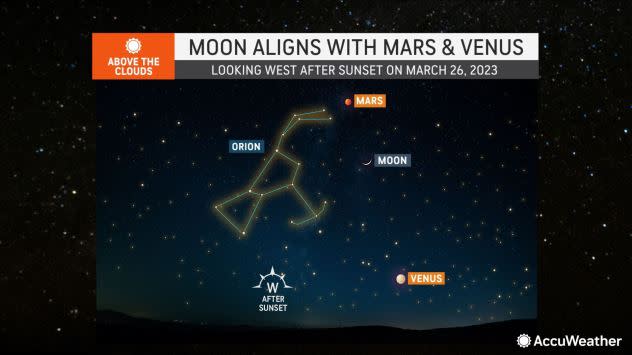Stargazers treated to another celestial line-up
Venus has emerged as a blazing bright planet in the western sky in recent weeks, outshining every star or planet during the first part of the night. And over the upcoming weekend, it will serve as the anchor for an astronomical alignment with the moon and another planet.
The two-night event started on Saturday, March 25, with the crescent moon appearing above Venus and topped off by Mars high in the western sky. The evening of Sunday, March 26, could be the better of the two nights to observe the trio since the moon will be split between the two planets.
 |
The famous constellation Orion will also appear in the western sky just to the left of Mars, the moon and Venus.
Orion is best seen from late autumn through early spring before it takes a cosmic leave of absence from the night sky. During the rest of the year, it cannot be observed, as it is in the same area of the sky as the sun.
With spring underway, the next few weeks will bring the final chances to glimpse the constellation before it temporarily vanishes from sight.
GET THE FREE ACCUWEATHER APP
•Have the app? Unlock AccuWeather Alerts™ with Premium+
In the middle of Orion sits a cluster of three stars known as Orion's belt, the easiest feature to pick out among a sea of stars in the heavens.
The red star Betelgeuse can also be seen near the top left of Orion. Betelgeuse is one of the most prominent stars visible to the naked eye and is classified as a red supergiant, one of the reasons why it is a different color than the other stars in the constellation.
Stargazers with a telescope can also zoom in on the constellation to get a better look at the Orion nebula, a massive cloud of gas and dust seen below Orion's belt.
 |
Betelgeuse glowing orange in the constellation Orion. (Pixabay/sl1990) |
The weekend alignment of Mars, the moon and Venus will be followed up by a close encounter with two of the objects early in the week.
Skywatchers looking to the west after sunset Monday, March 27, will see the moon shifting closer to the Red Planet. The moon will appear even closer to Mars on the evening of Tuesday, March 28, the closest they have appeared since the end of February.
Want next-level safety, ad-free? Unlock advanced, hyperlocal severe weather alerts when you subscribe to Premium+ on the AccuWeather app. AccuWeather Alerts™ are prompted by our expert meteorologists who monitor and analyze dangerous weather risks 24/7 to keep you and your family safer.




